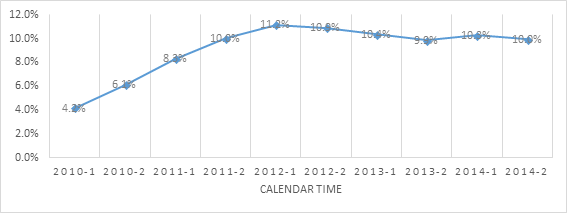Session Information
Session Type: ACR/ARHP Combined Abstract Session
Session Time: 9:00AM-11:00AM
Background/Purpose: Safety concerns related to osteoporosis (OP) medication use and temporary or permanent cessation of bisphosphonate therapy (e.g. ‘drug holidays’) have generated appreciable attention in the lay media and medical community. We examined trends and factors associated with BP drug holidays.
Methods: We assembled a cohort of women (‘OP cohort’) who had osteoporosis as diagnosed by a physician, fragility fracture, or were treated with any OP therapy using 2009-2015 Medicare data (100% sample). Women with Paget’s or malignancy were excluded. Use of any OP therapy was examined in 6 month calendar time intervals during which women had to remain alive with full medical & pharmacy coverage. We identified the subgroup of women (‘long term BP user cohort’) who had initiated BP therapy and were >=80% adherent with any BP for >=3 years. Women were considered to have taken a BP holiday if they had a gap in BP use > 12 months. We examined patterns of BP drug holidays over time, stratified in 6 month intervals and by cumulative duration of BP drug use.
Results: From a source population of more than 3 million women with osteoporosis, declining trends in use of all OP therapies were observed. Overall oral BP use fell by more than 50% from 2010 to 2014, although declines plateaued between 2012 and 2104. A total of 160,369 long-term BP users were identified, with mean (SD) age of 78.5 (7.5) years; 71% used alendronate and 51% used alendronate exclusively. Of these, 58,046 (36.2%) women had a BP drug holiday of >12 months. Approximately 10% of long term BP users discontinued each 6 month interval, reaching a peak in 2012 and continuing in a stable fashion thereafter (Figure). The timing of BP drug holidays peaked at a cumulative duration of 5-5.5 years of BP exposure. Numerous factors differed significantly between women taking drug holidays and those who did not including age, fragility fracture, and recent DXA.
Conclusion: Long term cessation of bisphosphonate therapy after 3-5 years of prior use has become increasingly common in the U.S. The impact on fracture risk and the optimal timing to restart remains of high importance.
Figure: Trends in Bisphosphonate Drug Holidays Over Time
To cite this abstract in AMA style:
Curtis JR, Chen R, Arora T, Daigle S, Matthews R, Yun H, Wright N, Jaleel A, Delzell E, Saag K. Temporal Trends and Factors Associated with Bisphosphonate Drug Holidays [abstract]. Arthritis Rheumatol. 2018; 70 (suppl 9). https://acrabstracts.org/abstract/temporal-trends-and-factors-associated-with-bisphosphonate-drug-holidays/. Accessed .« Back to 2018 ACR/ARHP Annual Meeting
ACR Meeting Abstracts - https://acrabstracts.org/abstract/temporal-trends-and-factors-associated-with-bisphosphonate-drug-holidays/

